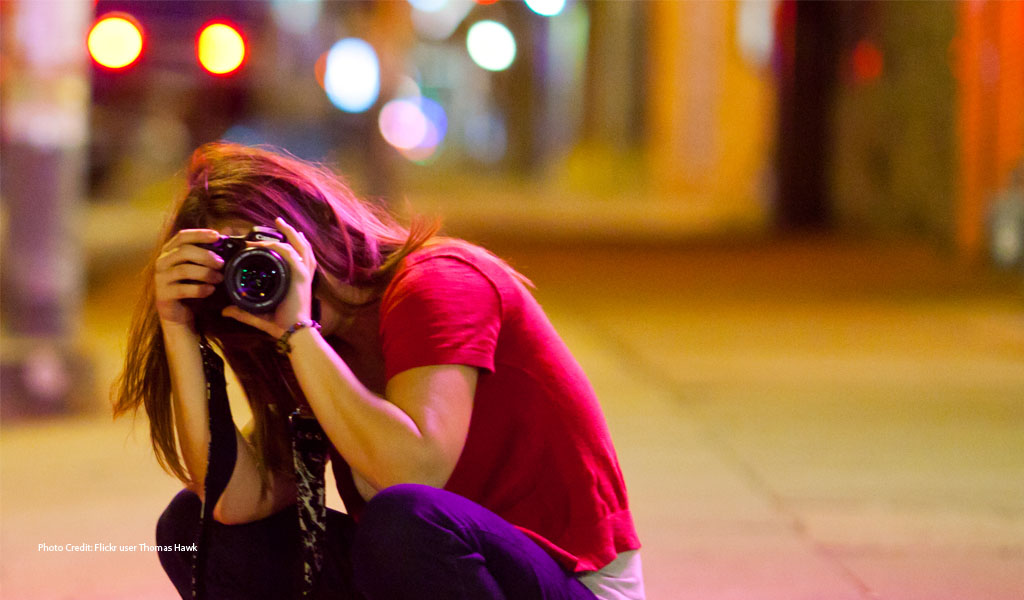
Protecting student journalists
Photo credit: Flickr user Thomas Hawk
Students doing more journalism in the “teaching hospital” model is a win for journalism education. But if universities want more from their student journalists, they should do more for them. That means legally protecting them even when the community and police don’t. Nationwide, universities are rightfully touting the benefits of the teaching hospital model. Yet students are missing from this debate.
Even if they weren’t interested in filling local news gaps with actual journalism, universities would seem to be obvious supporters and protectors of their students. Their roots, after all, are in freedom and learning. Ironically (and sadly) universities are often the first to challenge their own students for fear they might cause legal problems.
According to Frank LoMonte, Executive Director of the Student Press Law Center, most censorship complaints boil down to students vs. administration. The Knight-funded center serves students who believe they have been censored or denied access to public information. LoMonte estimated that about 70 percent of calls to their hotline are on the censorship and public information issues, with the school or college administration being the culprit.
What happens to student journalists? Schools have, for example, removed newspaper racks from campus, cut funding for school newspapers, locked out radio station staff members and restricted students from circling a petition around campus. Organizations such as the Student Press Law Center serve as valuable resources for students who feel their rights have been encroached upon.
It is not just the administration that tries to control student-run media. At times, community leaders are the problem. Recently, the staff of the independent University of Georgia newspaper, Red and Black, a non-profit corporation, walked out when it discovered a memo from a board member saying faculty must play a larger role in what would be published in the paper. The stated reason: an attempt to turn around a decline in readership. After the walkout, students created a website called Red and Dead where they covered their own story. After the outcry, the memo was dropped and the Red and Black editor-in-chief and managing editor returned.
Another all-to-typical example came in March when a Temple University student was arrested by Philadelphia police. Student photographer Ian Van Kuyk was arrested after taking pictures of a policeman pulling over a car. Van Kuyk was trying to satisfy a nighttime shot requirement for his photojournalism class. But the police lieutenant claims the student was doing more than taking pictures. The charges are obstruction, resisting arrest and disorderly conduct. Van Kuyk says his First Amendment rights were violated. His trail is set for Oct. 12.
The endless stream of similar stories discourages prospective journalists. Universities and communities must find ways to better work with students.
Important legal coverage for students can come in the form of shield laws. More than 30 states have shield laws to protect a reporter’s ability to keep information or sources confidential. But seven states narrowly define journalists as only those employed as full-time salaried reporters. This means students or “citizen journalists” lack protection. Those states include a fair chunk of America: Delaware, Florida, Indiana, Louisiana, Nevada, New York and Texas.
LoMonte mentioned Hawaii for having an “unconventional” definition that acknowledges journalists not only as those who are paid to gather and share news but also those who regularly publish and disseminate news to the public, permitting the inclusion of students and “citizen journalists.” Such a definition is more in tune with the current state of journalism in the digital age, where everyone in a sense can be a reporter.
West Virginia and Maryland took the lead as the only two states with shield laws that explicitly cover students. The SPLC helped write the West Virginia statute, which covers professional journalists and those enrolled in accredited academic (high school or college) programs. We need all the statues to say the word student – not just in 30 states with shield laws but in all 50.
As they do more journalism, schools are beginning to have more discussions about the legal risks involved. But those aren’t student-centered, either.
An example: The Carnegie Media Law For Journalism Schools Task Force Suggestions, developed by professor Geanne Rosenberg, was discussed at the 2012 AEJMC conference in August. It is a good starting point, offering a list of ideas that are intended to “advance journalism education while reducing legal risk.” Suggestions I liked include providing more legal training as well as access to media law experts for both students and faculty.
I believe the list should be expanded to include:
1. Campus and community law enforcement training about students’ rights.
2. Training for independent boards and administrators overseeing student-produced media, decreasing sensitivity to controversy and risk.
3. Universities creating policies to curb their abilities to interfere with students.
4. Schools pushing for the passage of shield laws in every state to protect their students.
Students who produce community journalism are heroically filling gaps in local news. They do not see themselves, nor are they, “legal risks” or “liabilities.” University-owned media should support a wide margin of error, allowing students to engage with their community and learn how to handle their own mistakes.
Communication programs market their student-run newspaper, radio and television programs to prospective students as hands-on learning experiences. Several promote the teaching hospital model. Yet unless there are changes, students will continue to be taught the opposite of what a free press can do. That’s not what they are going to school to learn.
Amber Robertson is a special projects contractor at Knight Foundation. She is a recent graduate of the University of Miami School of Communication and former general manager of WVUM, the student-run FM radio station there.
Recent Content
-
Journalismarticle ·
-
Journalismarticle ·
-
Journalismarticle ·


